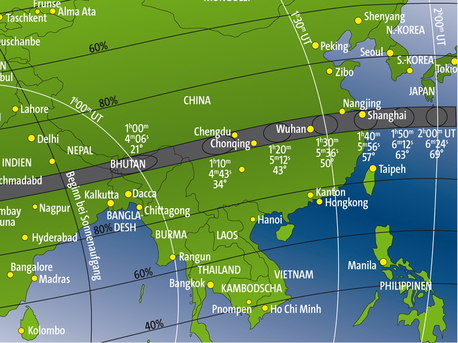Observation Highlight July
Black Sun over Asia
On July 22, 2009 the longest total eclipse in this century will take place. Unfortunately it will be impossible to observe it from North America or Europe. For all not fortunate enough to be in the middle of the action Redshift live presents a list of the most important webcasts and travel blogs. That way you can at least experience the total eclipse via webcast.
 © Kosmos Himmelsjahr |
Total Solar Eclipse Progression
The unfortunate fact is that the longest total solar eclipse of the 21st century cannot be observed from North America or Europe. For 6 minutes and 39 seconds the Moon will cover the Sun. The course of the eclipse starts in the west of India and goes eastwards. It passes India, Bhutan and China (including Shanghai) before the eclipse hits the pacific ocean south of Japan.
Live webcasts, pictures and reports of the eclipse can be found on the following websites:
The content is in English unless noted otherwise.
Webcasts
Amateur Astronomers Association Delhi (Indien - Varanasi & Sasaram)
Eclipse Chasers Athenaeum (Indien - Patna)
Chinese Astronomical Society (China, at least 8 different locations)
Atlaspost (China, site in Chinese)
Grupo Saros (China - Wuhan, site is in Spanish)
University of North Dakota (China - Wuhan)
Live! Eclipse 2009 (Japan, site is in Japanese)
Reports:
Website of Shelios 2009 (China - Huaying, site is in Spanish)
Astronomy.com (China - Wuhan)
Olivier Staiger (China - Shanghai)
Stephan Heinsius (China - Yangshan Island, site is in German)
If you know of any interesting blogs or tweeds please share them with us under isuggest@redshift-live.com
We will check them out and post them for everyone to see.
Redshift live
Live webcasts, pictures and reports of the eclipse can be found on the following websites:
The content is in English unless noted otherwise.
Webcasts
Amateur Astronomers Association Delhi (Indien - Varanasi & Sasaram)
Eclipse Chasers Athenaeum (Indien - Patna)
Chinese Astronomical Society (China, at least 8 different locations)
Atlaspost (China, site in Chinese)
Grupo Saros (China - Wuhan, site is in Spanish)
University of North Dakota (China - Wuhan)
Live! Eclipse 2009 (Japan, site is in Japanese)
Reports:
Website of Shelios 2009 (China - Huaying, site is in Spanish)
Astronomy.com (China - Wuhan)
Olivier Staiger (China - Shanghai)
Stephan Heinsius (China - Yangshan Island, site is in German)
If you know of any interesting blogs or tweeds please share them with us under isuggest@redshift-live.com
We will check them out and post them for everyone to see.
Redshift live
Observation Highlight July
Black Sun over Asia
On July 22, 2009 the longest total eclipse in this century will take place. Unfortunately it will be impossible to observe it from North America or Europe. For all not fortunate enough to be in the middle of the action Redshift live presents a list of the most important webcasts and travel blogs. That way you can at least experience the total eclipse via webcast.
 © Kosmos Himmelsjahr |
Total Solar Eclipse Progression
The unfortunate fact is that the longest total solar eclipse of the 21st century cannot be observed from North America or Europe. For 6 minutes and 39 seconds the Moon will cover the Sun. The course of the eclipse starts in the west of India and goes eastwards. It passes India, Bhutan and China (including Shanghai) before the eclipse hits the pacific ocean south of Japan.
Live webcasts, pictures and reports of the eclipse can be found on the following websites:
The content is in English unless noted otherwise.
Webcasts
Amateur Astronomers Association Delhi (Indien - Varanasi & Sasaram)
Eclipse Chasers Athenaeum (Indien - Patna)
Chinese Astronomical Society (China, at least 8 different locations)
Atlaspost (China, site in Chinese)
Grupo Saros (China - Wuhan, site is in Spanish)
University of North Dakota (China - Wuhan)
Live! Eclipse 2009 (Japan, site is in Japanese)
Reports:
Website of Shelios 2009 (China - Huaying, site is in Spanish)
Astronomy.com (China - Wuhan)
Olivier Staiger (China - Shanghai)
Stephan Heinsius (China - Yangshan Island, site is in German)
If you know of any interesting blogs or tweeds please share them with us under isuggest@redshift-live.com
We will check them out and post them for everyone to see.
Redshift live
Live webcasts, pictures and reports of the eclipse can be found on the following websites:
The content is in English unless noted otherwise.
Webcasts
Amateur Astronomers Association Delhi (Indien - Varanasi & Sasaram)
Eclipse Chasers Athenaeum (Indien - Patna)
Chinese Astronomical Society (China, at least 8 different locations)
Atlaspost (China, site in Chinese)
Grupo Saros (China - Wuhan, site is in Spanish)
University of North Dakota (China - Wuhan)
Live! Eclipse 2009 (Japan, site is in Japanese)
Reports:
Website of Shelios 2009 (China - Huaying, site is in Spanish)
Astronomy.com (China - Wuhan)
Olivier Staiger (China - Shanghai)
Stephan Heinsius (China - Yangshan Island, site is in German)
If you know of any interesting blogs or tweeds please share them with us under isuggest@redshift-live.com
We will check them out and post them for everyone to see.
Redshift live





